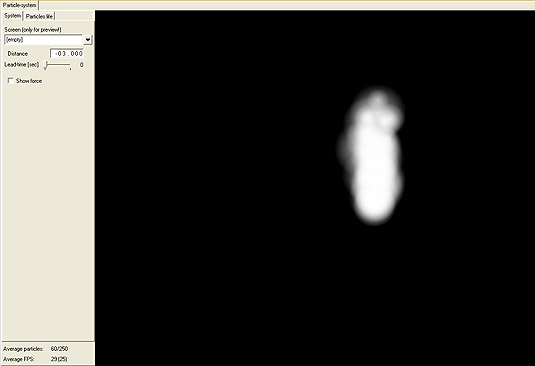Particle Basics: Difference between revisions
No edit summary |
|||
| Line 11: | Line 11: | ||
Below the area of parameters you find two measured values of the active particle-system: | Below the area of parameters you find two measured values of the active particle-system: | ||
[[Image: | [[Image:17_Par31.jpg]]<br /> | ||
* <font class="keyword">Average particles</font>: Number of particles that are currently "living" at the moment. The number may be below the maximum number of particles, depending on how much particles per time are generated and die. | * <font class="keyword">Average particles</font>: Number of particles that are currently "living" at the moment. The number may be below the maximum number of particles, depending on how much particles per time are generated and die. | ||
* <font class="keyword">Average FPS</font>: Tells us how many pictures per second are rendered. This number should be mostly about 40, if it is clearly below your personal computer is swamped with calculating the particle system. The number in brackets shows us how much balance time in ms per time step exists. It can therefore be considered as an approximate dimension for the power reserve of the system. | * <font class="keyword">Average FPS</font>: Tells us how many pictures per second are rendered. This number should be mostly about 40, if it is clearly below your personal computer is swamped with calculating the particle system. The number in brackets shows us how much balance time in ms per time step exists. It can therefore be considered as an approximate dimension for the power reserve of the system. | ||
Revision as of 21:25, 25 March 2006
screen layout
Every single particle-system can consist of several particle-emitters. On the left side of the screen the parameters of the particle-system are shown, on a second flag some parameters of the choosen particle emitters can be adjusted. The big preview area right hand shows the particle system as it will appear in the game.
Emitter belong to a particle-system like the objects belong to a game-scenery. As usual you find them down left. You have to create one particle-emitter at least so that something appears. (please see the figure below).
Attention: Aspect ratio and resolution of the preview area do not come up exactly to your game, because they are assigned by the resolution of the desktop and the size of the editor-window.
Below the area of parameters you find two measured values of the active particle-system:
- Average particles: Number of particles that are currently "living" at the moment. The number may be below the maximum number of particles, depending on how much particles per time are generated and die.
- Average FPS: Tells us how many pictures per second are rendered. This number should be mostly about 40, if it is clearly below your personal computer is swamped with calculating the particle system. The number in brackets shows us how much balance time in ms per time step exists. It can therefore be considered as an approximate dimension for the power reserve of the system.
A timestep has got 25ms. If the number in brackets reaches regularly 25, the calculating and drawing takes less than 1ms on your personal computer.
Attention:: If you exploit the power reserve of your computer completely with the particle system, no more time for the presentation of the game-graphics remains. The game-projector will react with a jerking particle system or if the worst comes to the worst with a jerking game.
